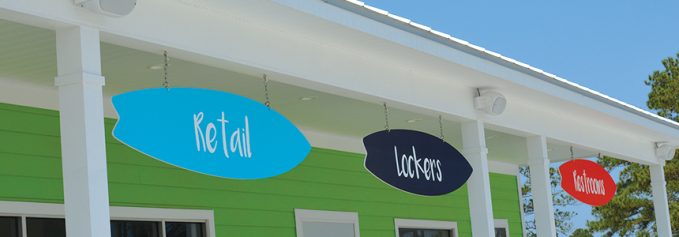
By Olivia Cahoon
Flatbeds enable direct printing onto rigid substrates. With the ability to output to a variety of materials, these devices are used for untraditional substrates such as wood, metal, and acrylic. Print service providers (PSPs) take advantage of this capability by offering new and creative rigid-based signage.
One such provider is Plak That based in Ocean City, MD. The shop began as a one person operation in 2012. From a 1,000 square foot garage, it originally offered photographic wood printing services to display surf imagery. “It was a new and unique way for people to print and display their photography so it was good business opportunity at the time,” comments Wyatt Harrison, owner, Plak That.
Since then, the company moved onto large format printing to a variety of different materials as well as CNC cutting and routing services. Plak That specializes in digital printing to wood, metal, and acrylic up to 4×8 feet, serving local, regional, and national customers. It immortalizes photographs and moments on custom wood, acrylic, PVC, and aluminum.
Currently, 80 percent of its business is digital printing with the remaining 20 percent CNC work. With five employees and a shop dog, the print provider operates out of a 2,000 square foot facility.
Above: Plak That of Ocean City, MD printed a variety of custom shaped signage for Maui Jack’s Waterpark using its Vanguard VR5D flatbed printer.
Custom Prints On Creative Materials
The shop offers several applications including awards, ornaments, outdoor signs, trophies, and wood-based materials. It prints on 3A Composites USA Dibond ACM, Plaskolite acrylics, Kommerling USA Komacel PVC, and variety of different woods hand selected from 100 percent Forest Stewardship Council certified sustainable sources.
Printing to untraditional substrates requires a heavy-duty industrial press. The print provider uses a 4×8-foot Vanguard Digital Printing Systems VR5D flatbed printer, selected for its speed, printhead technology, white ink capabilities, vacuum zones, and registration pins.
Plak That installed the VR5D in 2018, which allowed the company to move into more diverse areas of digital printing. “The machine has helped us open up more revenue streams for the business,” explains Harrison. The company moves products from the press to a CNC router for custom shapes and sizes.
The VR5D also prints in higher resolutions and faster speeds than Plak That’s previous flatbed device. According to Harrison, the ink coverage is better as well because it offers a double color configuration. Increased coverage helps to cover nozzle dropout from showing and prevents damage of printed products.
Supporting Technology
With its Vanguard VR5D, Plak That uses Vanguard proprietary inks to ensure UV curing strength and durability. Most of its products don’t require added protection except for wood. For wood-based projects, it applies a spray polyurethane finish.
In October 2017, the PSP acquired a 5×10-foot Biesse North America Rover Plast J FT CNC router with an automatic tool changer and camera system. With this device, the business dramatically reduces turnaround time compared to its traditional table saw finishing methods.
Software includes Onyx Graphics, Inc.’s ONYX Thrive for image processing. While its software accomplishes most of the business’ quality needs, color matching can be a challenge, especially on projects where clients need exact colors for branding or décor. “What you see on the screen sometimes doesn’t look the same when it is printed,” admits Harrison. As a result, Plak That generally does a lot of sample printing to address color issues before full production.
Waterpark Demand
In 2018, Maui Jack’s Waterpark approached Plak That for promotional materials to display in its new waterpark. The repeat client is a management company that needed to obtain high-quality and unique photographic signage for a new location.
“A lot of the printed material was informational and used in an outdoor setting so the prints had to be eye catching and durable,” shares Harrison.
Most of the signage was printed on white PVC for its outdoor durability and light weight for easy hanging. After printing on the Vanguard VR5D, the signs were finished on the Biesse Rover Plast J FT CNC router for custom-cut shapes, such as a surfboard height ruler. The shop also produced large acrylic artwork for the waterpark’s locker rooms.
Together, the VR5D and CNC router worked in tandem for quick print-to-cut capability. “All of these different systems worked well together in order to complete the project,” shares Harrison.
In total, Plak That produced 21 products including a variety of different printed custom shapes ranging from directional signs, photographic-quality work, price and package boards, signage, rider height rulers, and large logo cutouts. Each piece was either hung or nailed directly into the wall. It took Plak That one month to plan, design, print, cut, deliver, and install.
Plak That successfully completed the waterpark signage on time. According to Harrison, this job stands out from other projects because it allowed the company to use all of its digital printing equipment. “It was a true test to see how well each component worked together in producing custom print-to-cut signage,” he explains.
Customize Unique Substrates
Digital flatbed printers handle a range of substrates while offering customization. Plak That maintains the latest digital printing equipment and ensuring its color matching process is optimal. “Digital printing allows for high-quality prints, repeatability, consistency, and speed,” concludes Harrison.
Nov2019, Digital Output


